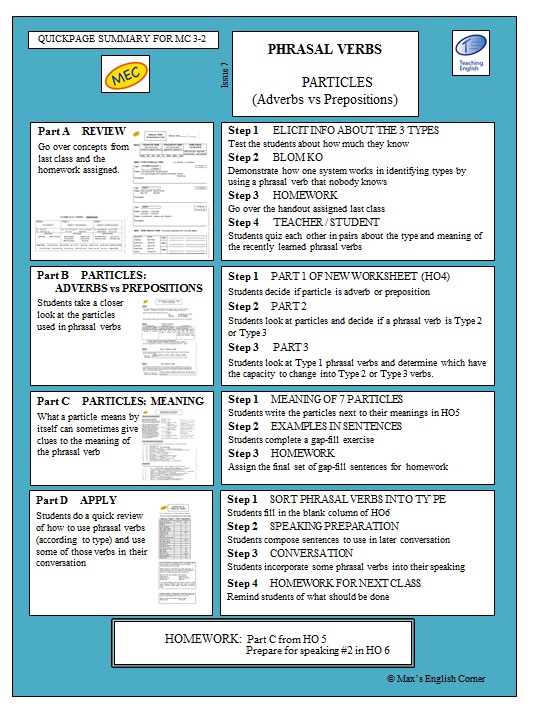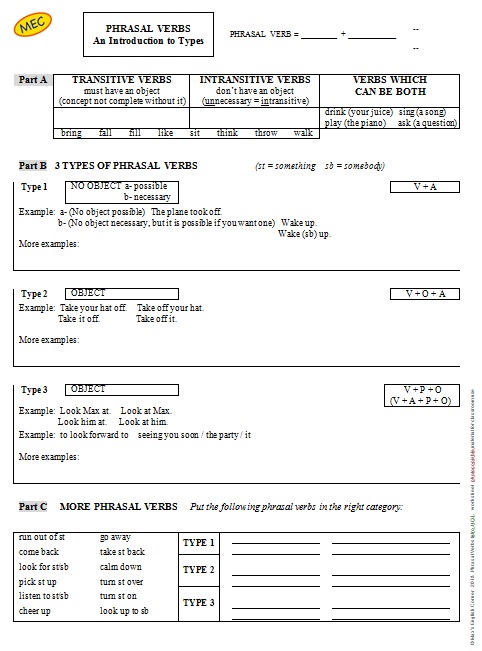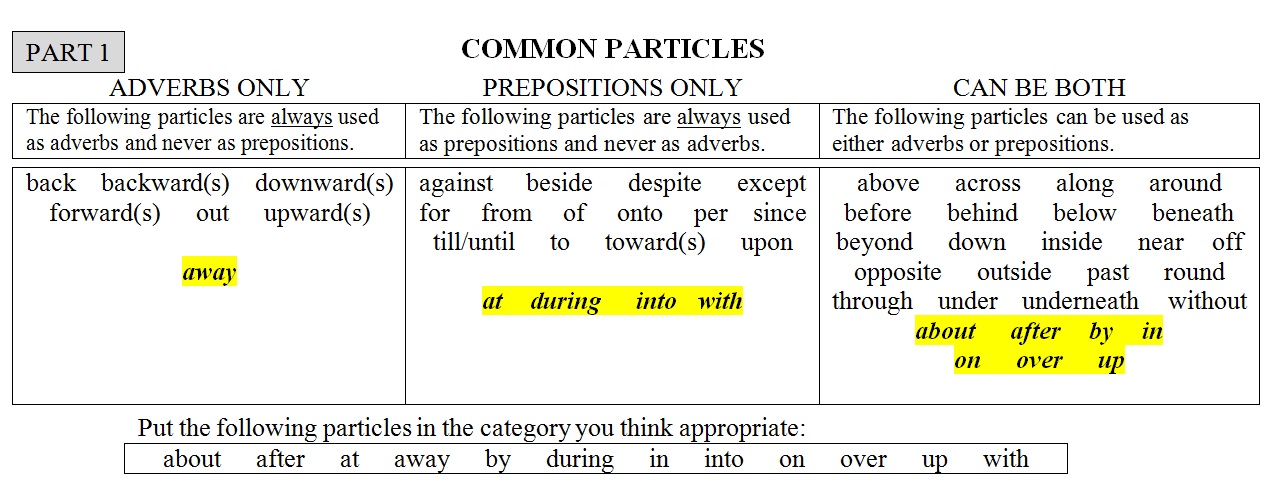Main Course 3-2 / PHRASAL VERBS / Day 2 of 3
GENERAL AIMS
- To increase students’ understanding of what a phrasal verb is and how it works
- To increase students’ awareness of how adverbs and prepositions are different and how they affect phrasal verbs
- To learn the meaning of certain particles
- To have students put into practice some of the ideas they have been exposed to and to incorporate phrasal verbs into their speaking
STEP SUMMARY
|
A |
Review |
Go over concepts and homework |
|
|
B |
Particles: Kinds |
Adverbs vs Prepositions |
|
|
C |
Particles: Meaning |
What do some particles mean? |
|
|
D |
Apply |
Exercises, speaking and homework |
RECOMMENDED LEVELS
Intermediate up
ACTIVITY TIME
about an hour
MATERIALS
- Board, screen or flip chart
- Handouts for class:
HO1 3 types worksheet
HO2 + Akey Low level homework
HO3 + Akey Higher level homework
HO4 + Akey Adv vs Prep worksheet
HO5 + Akey Particle meaning
HO6 + Akey Particles in phrasal verbs
SPECIAL NOTES
– Note 1 deals with concepts from last class
– Note 2 deals with issues from today’s class
Quickpage
Class Plan
PART A: REVIEW
| A | STEP 1 | ELICIT 3 TYPES REVIEW PHRASAL VERBS | |||||
| a) | Tell the students not to look at their notes or the handout from last class. (You can.) | ||||||
| b) | Ask the class for the 3 types and as much information as they can recall.
(what each type is composed of, how they can be used, an example or two of each) |
||||||
| c) | Ask them if they have any questions. | ||||||
| d) | – optional – Randomly ask different students a few questions. For example: | ||||||
| 1) If the phrasal verb has 2 particles what type is it? (Type 3) | |||||||
| 2) Which type of phrasal verb can use the pronoun form of the object at the end? (Type 3) | |||||||
| 3) What type of phrasal verb is wake up? (It’s Type 1 but it can be used as a Type 2 if there is an object) | |||||||
| 4) What’s the difference between take off and take something off? | |||||||
| Take off Type 1 | no object | means leave the ground | |||||
| Take st off Type 2 | requires object | means to remove something | |||||
| (which can be placed in the centre) | |||||||
| 5) How many different ways can turn the TV off be expressed?
(3: turn the TV off turn it off turn off the TV) |
|||||||
| A | STEP 2 | BLOM KO REVIEW PHRASAL VERBS | |||
| a) | Write on the board: blom ko | ||||
| b) | Tell the students to imagine this to be a phrasal verb that they have never seen before, where blom is the verb and ko is the particle. | ||||
| c) | Ask the students what type (1, 2 or 3) of phrasal verb blom ko is, and why.
Type 1 because there is no object given. |
||||
| d) | Write on the board: blom ko sb and elicit what type it is.
Type 3 because there is an object and it’s placed at the end. |
||||
| e) | Continue writing on the board and eliciting the following: | ||||
| blom sb/st ko | Type 2 It has an object placed in the centre. | ||||
| blom (sb) ko | Type 1 but it can be a Type 2 if an object is used. | ||||
| blom ko (sb/st) | Type 1 but it can be a Type 3 if an object is used. | ||||
OR
| A | STEP 3 | REVIEW HOMEWORK REVIEW PHRASAL VERBS | |
| a) | Ask the students to take out the handout they were assigned for homework last class. (This would be HO 2 or HO 3, depending on the one you chose for them.) | ||
| b) | Elicit the answers and respond to any questions. | ||
| A | STEP 4 | TEACHER / STUDENT REVIEW PHRASAL VERBS | |
| a) | Place the students into pairs, one taking the role of the ‘teacher’ and the other, the ‘student’. | ||
| b) | The ‘teacher’ has the handout given out for homework (either HO 2 or HO 3), says a phrasal verb from the handout and the student has to say which type it is (1, 2 or 3) and its meaning. | ||
| c) | Students don’t change roles. | ||
| d) | Continue for 2 minutes or until one group finishes, whichever comes first. | ||
PART B: PARTICLES – – ADVERBS vs PREPOSITIONS
| B | STEP 1 | INTRO & PART 1 of HO4 PARTICLES: ADV vs PREP PHRASAL VERBS | |
| a) | Give the students HO 4 (Handout 4 on the Particles of Phrasal Verbs) and go through the intro section together. | ||
| b) | Refer the students to Part 1 of the worksheet. Let them read the examples in each of the 3 groups on their own. | ||
| c) | When they are done, respond to any questions they might have. | ||
| d) | Direct their attention to the long rectangular box with 12 particles below the 3 boxes. Tell the students to place them into the box they think is correct. They can work it out or guess in pairs. | ||
| e) | Go over the answers together. | ||
| B | STEP 2 | PART 2 of HO4 PARTICLES PHRASAL VERBS | |
| a) | Students look at the verbs in Part 2. Ask them how they could correctly decide if they are Type 2 or Type 3.
(If the particle is an adverb, it’s Type 2. If it’s a preposition, then Type 3.) |
||
| b) | Tell them to do the exercise individually and later check their answers with the student next to them. | ||
| c) | Go over the answers. | ||
| B | STEP 3 | PART 3 of HO4 PARTICLES PHRASAL VERBS | |
| a) | Tell the students that all the phrasal verbs in Part 3 are Type 1. In the form they are shown, there is no object. All of these particular phrasal verbs can take an object, but some would become a Type 2 and the others would need an accompanying preposition to become a Type 3. | ||
| b) | Tell the students to work in pairs to try and decide which of the verbs are Type 2 and which are Type 3. Remind them that they must include the prepositions for any examples in the Type 3 group. | ||
| c) | Go over the answers together. | ||
PART C: PARTICLES – – MEANING
| C | STEP 1 | HO5 MEANING OF 7 PARTICLES PHRASAL VERBS | |
| a) | Write on the board the following 7 particles and elicit what they may mean. (No other writing is necessary.) | ||
| up down over away on off back | |||
| b) | Give HO5 to the students and have them put those particles in the 7 boxes next to their definitions. | ||
| c) | Go over the answers and the examples in sentences to the right of the definitions. | ||
| C | STEP 2 | HO5 NEW EXAMPLES IN SENTENCES PHRASAL VERBS | ||
| a) | Tell the students to look at the middle section with 15 sentences. | |||
| b) | For each sentence they must do 2 things: | |||
| 1- Write the particle in the blank in the sentence. | ||||
| 2- Write the number of the meaning next to the letter of the sentence. (There’s an example.) | ||||
| c) | Students do the exercise individually, then check their answers with another student. | |||
| d) | Go over the answers and any questions they might have. | |||
| C | STEP 3 | HO5 HOMEWORK PHRASAL VERBS | |
| a) | Tell the students to do the same thing with the final group of 12 sentences for homework. | ||
| b) | Remind them to write the definition number too, not just the particle. (all 15 numbers are to be used.) | ||
| c) | Point out that some sentences have two blanks for two different particles. | ||
PART D: APPLY
| D | STEP 1 | HO6 SORT INTO TYPE APPLY PHRASAL VERBS | |
| a) | Have the students look at the table at the top of HO 6. Point out that the meaning of the particles used (not necessarily the phrasal verb itself) has a reference in the third column to the meanings discussed in HO 5. | ||
| b) | Ask the students to look at the phrasal verbs and clarify any doubts they might have about meaning or pronunciation. | ||
| c) | Tell them to fill in the second column, which shows which type of phrasal verb each one is. | ||
| d) | Go over the answers with the students. | ||
| D | STEP 2 | HO6 SPEAKING PREPARATION APPLY PHRASAL VERBS | |
| a) | Tell the students that they will soon engage in a conversation about their families and use some of the phrasal verbs provided. Before they begin speaking, they are to prepare a little first. | ||
| b) | Tell them that they are to use some of the phrasal verbs in the table they have just completed and there are six more in the box below it. Go over the meaning of those six and encourage the students to use at least one or two from that group as well. | ||
| c) | Give the students 5 to 10 minutes (depending on the level and the interest of the class) to write a few sentences with those phrasal verbs, in a way that they would use them naturally in the coming conversation. Monitor and respond to questions while they are writing. | ||
| D | STEP 3 | HO6 CONVERSATION APPLY PHRASAL VERBS | |
| a) | Assign the students to groups of 3 or so and tell them to discuss the theme (5 to 10 minutes, or depending upon the involvement they have during the activity), using the phrasal verbs. It is not uncommon for the students to have doubts or not use the target language exactly as it should be, so monitor the groups while they are speaking. | ||
| b) | Give some feedback at the end of the speaking activity, highlighting where they did well and a few points they might benefit from. | ||
| c) | – optional – Refer the students to the box at the bottom. In the next class they will be doing a similar activity, but speaking about school or work. They can have the same list of phrasal verbs as covered on HO6, including the two new ones (take (st) over and do st over). Introduce these two verbs (elicit / explain) and tell the students that they can prepare something for when they will speak next class or can improvise if they haven’t prepared anything. | ||
| D | STEP 4 | REMIND STUDENTS OF HOMEWORK PHRASAL VERBS | |
| a) | Part C from HO5 They have to do the homework section at the end. | ||
| b) | If phrasal verbs are difficult to use in their speaking, it is recommended that they prepare something for the speaking activity at the end of HO6. (This is assuming that you want to do this activity next class.) | ||
| c) | The students should have a good look at the various handouts they have received in today’s and last class. The next class will be dedicated to more speaking activities where they will be expected to use phrasal verbs. | ||














